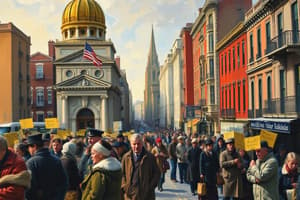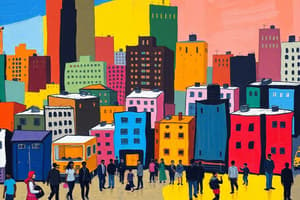Podcast
Questions and Answers
What was the primary reason Bridget Murphy and Patrick Kennedy immigrated to the United States?
What was the primary reason Bridget Murphy and Patrick Kennedy immigrated to the United States?
They were fleeing the potato blight that had devastated Irish agriculture and caused starvation.
Where did the young couple settle after arriving in America?
Where did the young couple settle after arriving in America?
Noddle's Island in Boston Harbor.
What job did Patrick Kennedy find in America?
What job did Patrick Kennedy find in America?
- Baker
- Farmer
- Cooper (correct)
- Blacksmith
The Irish formed the first immigrant ghetto in the United States?
The Irish formed the first immigrant ghetto in the United States?
What challenges did the Irish immigrants face in their new home?
What challenges did the Irish immigrants face in their new home?
What event caused Patrick Kennedy's death?
What event caused Patrick Kennedy's death?
What did Bridget do to support herself and her son after Patrick's death?
What did Bridget do to support herself and her son after Patrick's death?
Flashcards
Irish Immigration
Irish Immigration
The influx of Irish people to the US, primarily due to the potato famine.
Urbanization
Urbanization
Growth of cities and population density.
Labor Shortages
Labor Shortages
Demand for workers high due to industrial growth.
Nativist Attacks
Nativist Attacks
Signup and view all the flashcards
Social Reform
Social Reform
Signup and view all the flashcards
Free Labor
Free Labor
Signup and view all the flashcards
Immigration Ghetto
Immigration Ghetto
Signup and view all the flashcards
Middle-Class Reform
Middle-Class Reform
Signup and view all the flashcards
Potato Blight
Potato Blight
Signup and view all the flashcards
Industrial Growth
Industrial Growth
Signup and view all the flashcards
Study Notes
Immigration, Urban Life, and Social Reform in the Free-Labor North (1838-1860)
- Immigration to the Free-Labor North (1838-1860) swelled the ranks of the wage labor force.
- The period saw significant transformations in American labor, shifting away from agriculture towards industrialization and urban life.
- Immigrants, (particularly Irish and German), filled many jobs in industries, construction, and domestic service.
- Irish immigrants faced significant hardship, including the potato famine, leading to their large-scale immigration to the United States.
- The massive influx of immigrants led to nativism and prejudices against immigrants.
- Urban centers experienced significant growth and development, with accompanying urban disorder and social problems (crime, poverty, and disease).
- Middle-class reformers reacted to urban problems with efforts to improve moral and social conditions in cities.
- Leisure activities and class conflicts were evident in the urban landscape.
- New technologies and transportation (canals and railroads) transformed communication, trade, and settlement patterns.
The Transformation of the American Labor Force
- The period (1838-1860) witnessed a shift from agricultural to industrial life.
- Immigrants (Irish, German, others) filled many new industrial jobs.
- Wages and employment fluctuated, with periods of economic hardship and prosperity.
- Women and African Americans faced limited opportunities despite working in industries and domestic service.
- The growing wage-earning workforce led to greater competition for jobs.
Urban Mayhem and Middle-Class Reform
- Urban areas often faced conflicts between social classes and increasing crime and poverty.
- Leisure activities (including sports, theaters, and public events) were popular among various social groups.
- Some urbanites' (particularly the middle class) conduct and behavior in public spaces concerned others.
- Urban reformers sought ways to improve living conditions, access to education, and moral standards in cities.
Reform Movements and Social Issues
- Abolitionism, temperance movements, and women's rights campaigns were part of this era.
- Nativism played a major role (prejudice and hostility towards immigrants, particularly Catholic immigrants).
- Religious differences and class conflict played a significant part.
- Land reform movements sought to address issues of unequal land ownership.
- Communal/utopian communities explored alternative social and economic models.
- Social reformers engaged in efforts to uplift societies by promoting temperance, education, and reform in various other areas of social progress.
Studying That Suits You
Use AI to generate personalized quizzes and flashcards to suit your learning preferences.




